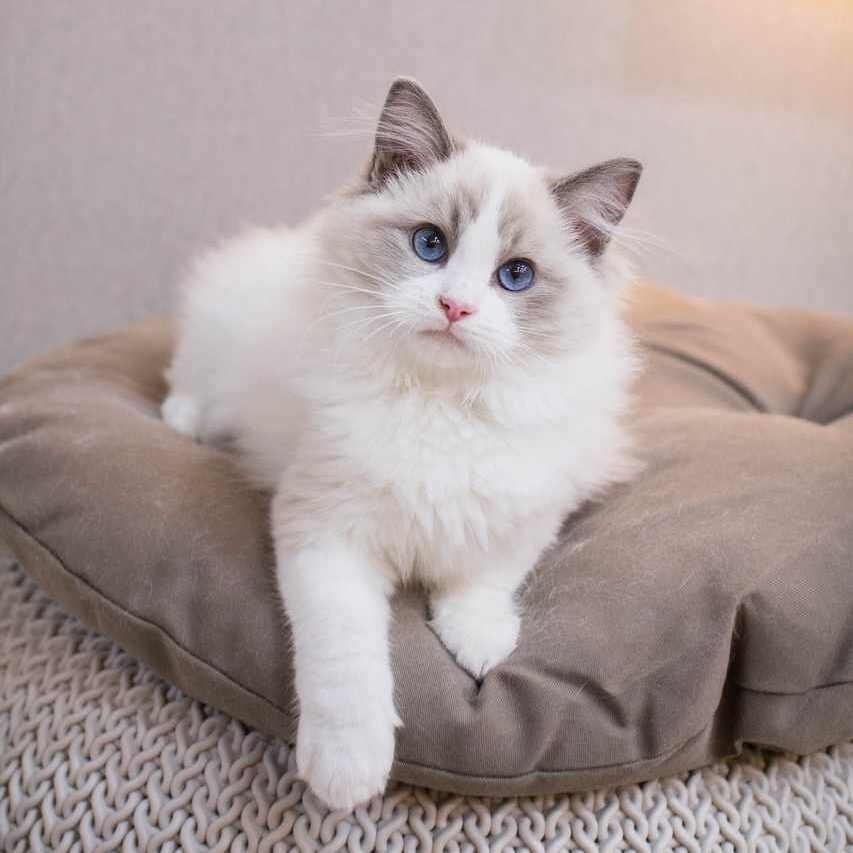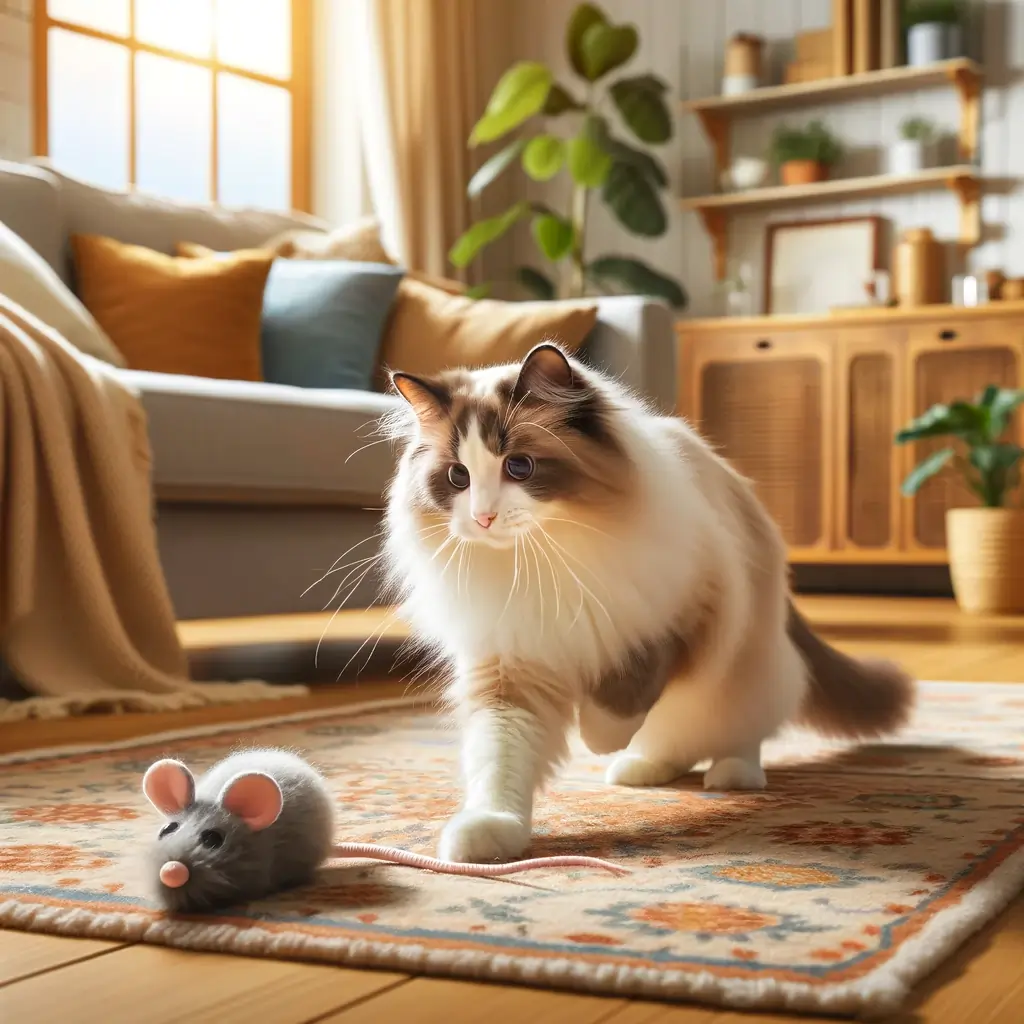Yes, Ragdoll cats do hunt mice despite their calm demeanor. Their hunting instincts surprise many due to their gentle nature. These cats possess efficient hunting techniques that make them successful predators. Their large size and agility give them an advantage in stalking prey.
Ragdolls exhibit a strong prey drive inherited from their ancestors. If you’re curious about how these gentle felines engage in precise and stealthy hunting maneuvers, and how you can stimulate their instincts through playtime, keep exploring the intriguing domain of Ragdoll cats and their hunting behaviors.
Ragdoll Cats: Natural Hunters?
Are Ragdoll cats instinctual hunters, or do they prefer a more relaxed lifestyle?
Ragdolls may have a gentle demeanor, but they still possess natural hunting instincts. When it comes to hunting techniques, Ragdolls mightn’t be as aggressive as some other breeds, but they do showcase their skills in a more calculated manner.
Their preferred prey often includes smaller animals like mice due to their gentle nature. Despite their laid-back attitude, Ragdolls can surprise with their hunting success. Their large size and agility give them an advantage when stalking prey, making them quite efficient hunters when they decide to tap into their innate skills.
Instinctual Prey Drive in Ragdolls
Ragdoll cats, known for their gentle demeanor, exhibit a surprising instinctual prey drive, particularly when it comes to hunting smaller animals like mice. Despite their docile nature, these felines still retain strong hunting instincts inherited from their ancestors.
Their prey drive can manifest in various ways, from stalking behavior to pouncing on toys that mimic prey movements. This hunting behavior is deeply ingrained in their DNA, making it a natural inclination for Ragdolls to engage in hunting activities.
Owners may observe their Ragdoll cats displaying behaviors such as crouching low to the ground, silently tracking movements, and swiftly attacking objects that trigger their predatory instincts.

Mouse Hunting Behavior in Ragdolls
When observing mouse-hunting behavior in Ragdolls, it becomes evident that their instincts drive them to engage in stealthy and precise maneuvers. Ragdolls, known for their gentle nature, can surprise with their adept hunting skills when it comes to rodent control.
Their training methods often involve interactive indoor playtime that mimics hunting games to stimulate their instincts. By incorporating activities like feather toys or treat puzzles, owners can provide outlets for their Ragdolls to satisfy their hunting desires in a safe and controlled environment.
Understanding and encouraging these behaviors not only enriches the cat’s life but also helps maintain a balanced and happy feline companion within the household.
Training Ragdolls to Hunt Mice
Observing Ragdolls’ instincts during mouse hunting behavior reveals the potential to train them effectively in rodent control techniques.
When considering training techniques for Ragdolls to hunt mice, it’s vital to understand their innate mouse behavior and prey drive.
Utilizing positive reinforcement is key to encouraging Ragdolls to hone their hunting skills.
Here are some essential strategies for training Ragdolls to hunt mice:
- Utilize interactive toys: Incorporating toys that mimic mouse movements can help stimulate the Ragdoll’s prey drive.
- Reward successful hunts: Using treats or praise as a positive reinforcement when the cat successfully catches a toy mouse can reinforce hunting behavior.
- Practice stalking and pouncing: Engaging in play sessions that involve stalking and pouncing can help simulate hunting scenarios for Ragdolls.
- Provide opportunities for real-life hunting: Allowing Ragdolls access to safe outdoor spaces or supervised indoor areas with mice can enhance their hunting skills.
Factors Affecting Hunting Abilities
Factors influencing hunting abilities in cats include their age, health status, and previous exposure to hunting scenarios. Younger cats tend to have a higher prey drive and are often more successful hunters compared to older cats.
Additionally, a cat’s overall health can impact its hunting success, as a strong and agile cat is more likely to catch prey effectively. Cats that have been exposed to hunting from a young age are more skilled hunters than those who haven’t had similar experiences.
Prey drive, which is an instinctual motivation to hunt, varies among individual cats and can greatly affect their hunting abilities. Understanding these factors can help cat owners better assess and support their feline companions’ hunting instincts.
Ragdolls Vs. Other Cat Breeds
Comparing Ragdoll cats to other cat breeds reveals distinctive characteristics regarding their hunting behaviors and prey drive. Ragdolls’ hunting skills compared to other breeds are notable for their more laid-back approach towards hunting. While Ragdolls have an instinct to hunt, they often lack the same level of intensity and focus as breeds specifically bred for hunting purposes.
This can make them less efficient hunters when compared to breeds like Siamese or Bengals. Ragdolls’ prey drive tendencies tend to be lower, resulting in a reduced motivation to actively seek out prey. Their gentle and docile nature may make them less likely to engage in hunting behaviors compared to more predatory cat breeds.
- Ragdolls have a more relaxed hunting style.
- They lack the intense focus of breeds bred for hunting.
- Ragdolls exhibit lower prey-drive tendencies.
- Their gentle nature may impact their hunting motivation.
Real-Life Examples of Ragdolls Hunting
We’ve witnessed firsthand the impressive hunting instincts of Ragdoll cats. They have a knack for successful hunts, surprising us with their agility and precision.
Beyond their efficiency, Ragdolls infuse playfulness into their hunting, making the process both entertaining and effective.
Ragdolls’ Hunting Instincts
How do Ragdoll cats showcase their hunting instincts in real-life scenarios? While Ragdolls are known for their gentle and docile nature, they still exhibit their innate hunting behaviors in various situations. Here are some examples of how Ragdolls demonstrate their hunting instincts:
- Stalking Toys: Ragdolls may display stalking behaviors when playing with interactive toys, showing their natural inclination to hunt.
- Chasing Laser Pointers: Ragdolls enjoy chasing laser pointers, mimicking the act of hunting prey in a safe and controlled environment.
- Pouncing on Moving Objects: Ragdolls might pounce on moving objects like insects or fast-moving toys, reflecting their hunting instincts.
- Exploring Indoor Enrichment Activities: Engaging in indoor enrichment activities like puzzle feeders can stimulate Ragdolls’ hunting instincts in a domestic setting.
Ragdolls’ Successful Hunts
In our neighborhood, Ragdoll cats have been observed successfully catching mice in the backyard. Their hunting success is impressive, showcasing the natural mouse-catching skills that Ragdolls possess.
These elegant felines demonstrate a keen ability to stalk their prey with precision and agility. One particular Ragdoll named Luna has become quite renowned for her hunting prowess, often returning home with a catch after a successful expedition in the garden.
Watching these Ragdolls in action is a confirmation of their innate hunting instincts and ability to excel in their role as skilled predators. The sight of a Ragdoll cat on the prowl is a reminder of their ancestral hunting heritage, where their graceful demeanor belies their efficient hunting capabilities.
Ragdolls’ Playful Hunting
Observing Ragdoll cats in their playful hunting endeavors provides a delightful glimpse into their instincts and agility. These feline companions exhibit a charming mix of curiosity and precision when engaging in hunting games around the house.
Here are some real-life examples of Ragdolls’ playful hunting behaviors:
- Playful Stalking: Ragdoll cats are known for their playful stalking techniques, where they mimic the movements of a stealthy predator.
- Toy Pounce: Their hunting instincts shine through as they pounce on toys, showcasing their agility and quick reflexes.
- Chasing Shadows: Ragdolls often engage in chasing shadows, displaying their playful yet instinctual pursuit behaviors.
- Interactive Play: Engaging in interactive play sessions with their humans allows Ragdolls to satisfy their hunting instincts safely and enjoyably.

Ethical Considerations of Hunting
Considering the impact on wildlife populations, ethical hunting practices are essential for maintaining ecological balance. It is vital to balance animal welfare and hunting ethics with conservation efforts and predator-prey dynamics. Responsible hunting helps regulate animal populations, preventing overpopulation that can lead to habitat destruction and food scarcity. To engage the audience further, let’s explore the key aspects of ethical hunting in the table below:
| Ethical Hunting Practices | Description | Importance |
|---|---|---|
| Animal Welfare | Prioritizing humane treatment of prey | Ensures ethical conduct |
| Hunting Ethics | Adhering to laws and regulations | Upholds moral standards |
| Conservation | Maintaining biodiversity and ecosystems | Preserves ecological balance |
| Predator-Prey Dynamics | Understanding natural relationships | Supports ecosystem health |
Tips for Encouraging Hunting Instincts
To develop a cat’s natural hunting instincts, engaging them in interactive play with toys mimicking prey can be highly effective. When encouraging hunting behaviors in cats, interactive toys and specific training techniques can be beneficial. Additionally, providing indoor enrichment activities can stimulate their predatory instincts.
Feeding puzzles are another great way to engage a cat’s hunting skills while also providing mental stimulation. Here are some tips for encouraging hunting instincts in cats:
- Utilize interactive toys for play sessions
- Implement training techniques that mimic hunting behaviors
- Create indoor enrichment opportunities
- Incorporate feeding puzzles into their mealtime routine
Frequently Asked Questions
Are Ragdoll Cats Prone to Bringing Back Their Prey?
When it comes to prey retrieval, Ragdoll cats may exhibit hunting behavior. Their instincts drive them to engage in play with mouse toys or even bring back found items. It’s a fascinating aspect of their nature.
Can Ragdolls Distinguish Between Real Mice and Toys?
When it comes to Ragdolls, distinguishing between toy mice and real prey is a blend of instinct and playtime. They showcase their hunting prowess but also enjoy a playful chase with toy mice, showcasing their versatility.
Do Ragdolls Hunt in Groups or Alone?
When it comes to hunting behavior, group dynamics can vary among cats. Some felines prefer solitary hunting due to their territorial instincts, while others might engage in group hunts. It all depends on the individual cat’s preferences.
Are Ragdolls More Efficient Hunters at Night?
When the sun sets, our Ragdoll cats reveal their inner predators. Their nocturnal habits enhance hunting success. Under the moon’s glow, they masterfully employ stealthy techniques for prey retrieval, proving their efficiency in the dark.
How Do Ragdolls React to Catching Mice for the First Time?
When exploring their instinctual behaviors, we’ve noticed Ragdolls exhibit a strong hunting drive. Their reaction to prey capture can vary, from curiosity to playfulness. Observing them catch mice for the first time is fascinating.
Conclusion
To sum up, while Ragdoll cats may not hunt mice as enthusiastically as some other breeds, they still possess the instincts to do so.
With patience and training, Ragdolls can learn to embrace their inner hunter and enjoy the thrill of the chase.
Remember, every cat is different and may have their unique approach to hunting.
So, let’s allow them to follow their instincts and hunt to their heart’s content.

Hey guys, My name is Simon Smith. I’m from Canada and live near Victoria
I live with my sweet family and have 20+ Ragdolls of different types. I love them as my children. My profession is as a hotel manager.
I love to keep Ragdolls and grow their breeder case. I have 7 years of experience.
I’m an expert in cat care. So, I’m here to provide you with new information about my cats daily. This is my blog website, so I request that you kindly visit our site daily.
If you’re a Ragdolls lover and you have any questions or confusion about cats, text me on the Contact Us page or Gmail.
Thank u
